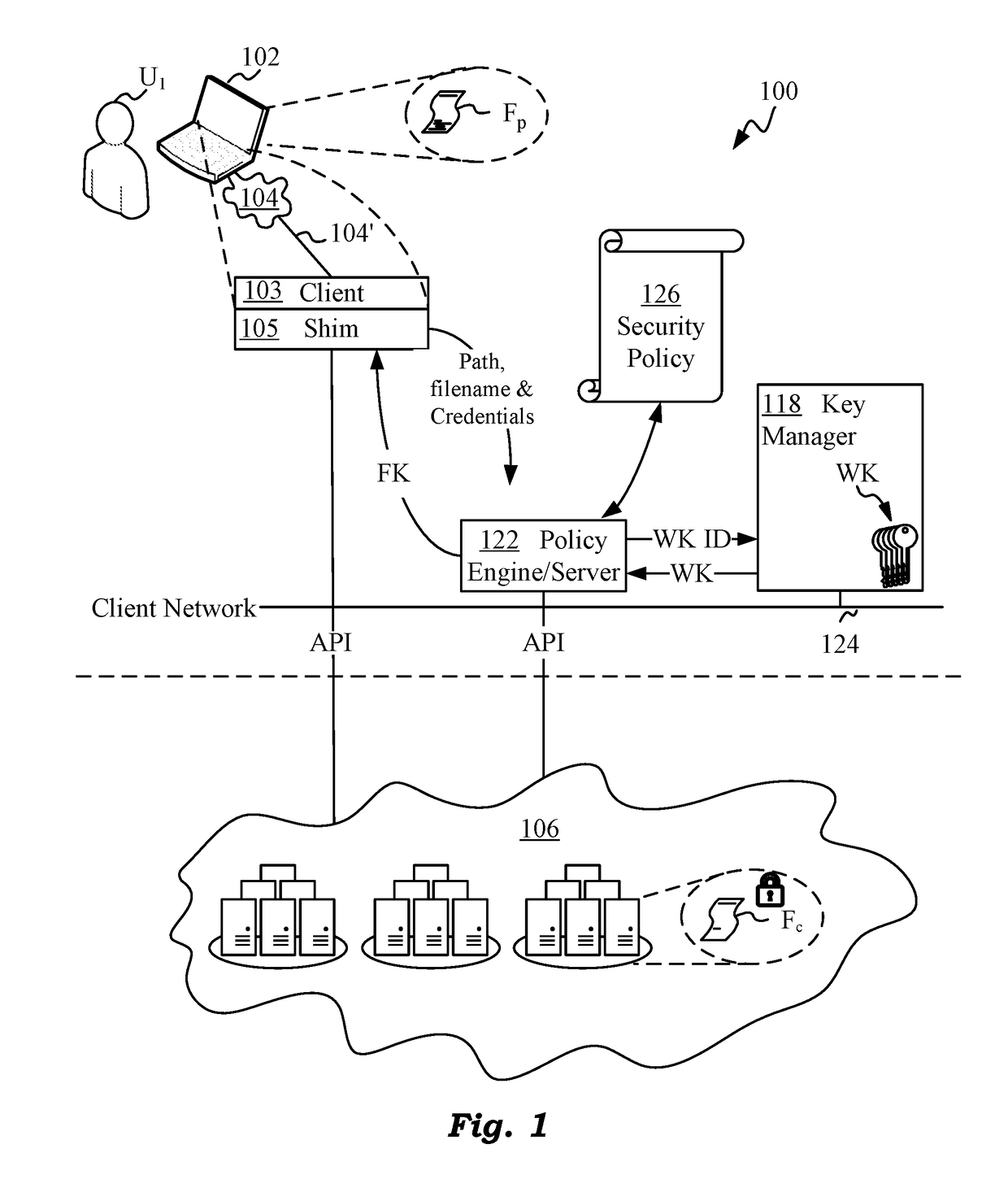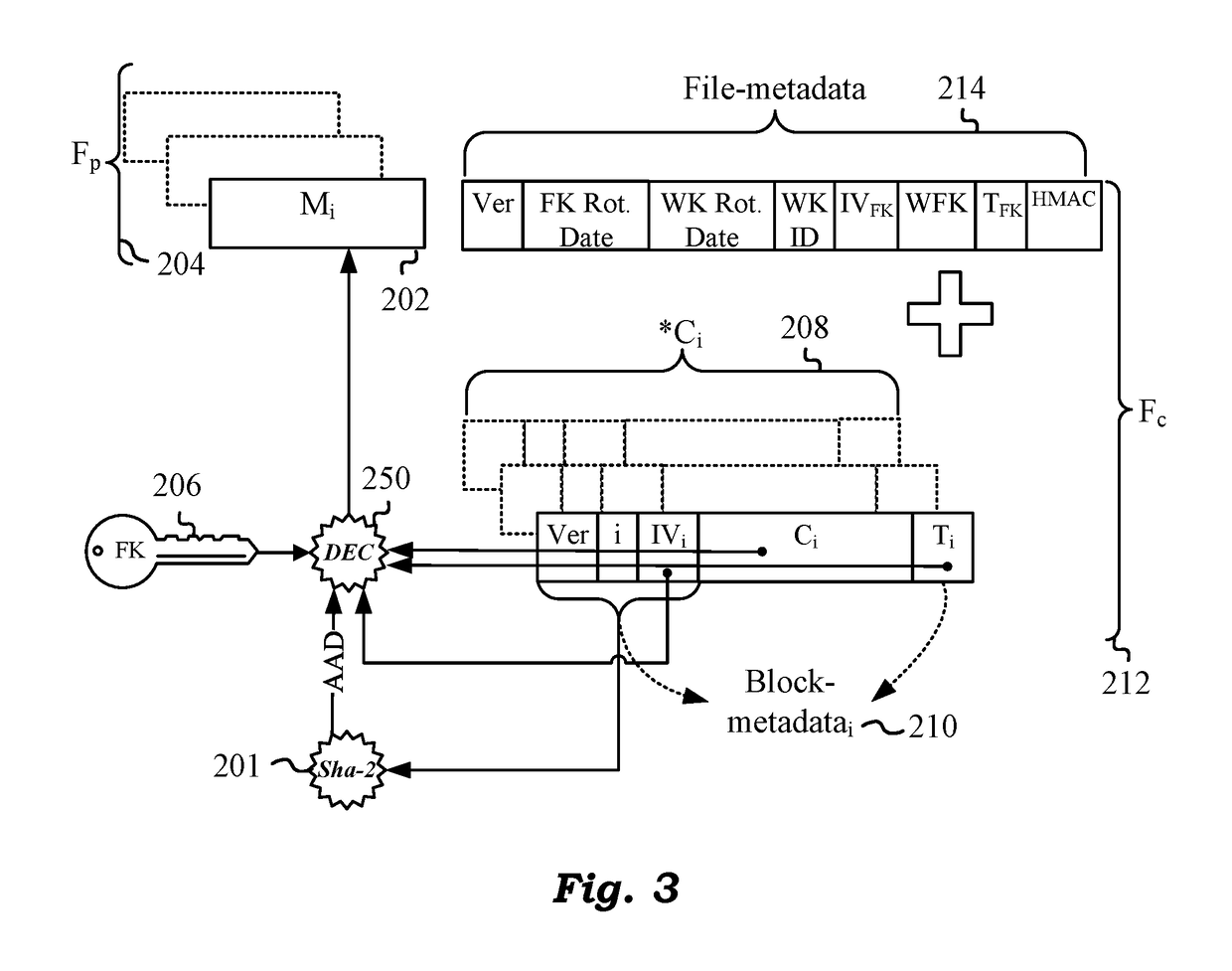Cloud Storage Encryption With Variable Block Sizes
a cloud storage and variable block size technology, applied in the field of cybersecurity, can solve the problems of posing new challenges to data security, users cannot run code in a pure file storage service, and exercise is usually more expensive and complicated than a cloud storag
- Summary
- Abstract
- Description
- Claims
- Application Information
AI Technical Summary
Benefits of technology
Problems solved by technology
Method used
Image
Examples
example # 1
EXAMPLE #1
[0272]1. DBS=5 bytes and at physical offset 10, there is a 2-byte block.[0273]2. BT contains one entry, physical offset=10, length=2, or (physical offset, length)=(10,2).[0274]3. Read request is for virtual offset=7, length=2 or two bytes starting at offset, or (virtual offset, length)=(7,2).[0275]4. Shim 105 checks the BT and sees that there are no entries before 7+2 bytes. So, the block size in that area must be DBS.[0276]5. Shim 105 reads and decrypts the 5 bytes starting at physical offset 5 per box 356 of flowchart 350 and the above explanation. It then returns the 2 bytes starting at physical offset 7 to the client. Note that in this example, physical offset=virtual offset.
example # 2
EXAMPLE #2
[0277]1. DBS=5 and BT contains entries (physical offset, length)=(10,2) and (17,2).[0278]2. Read request is for (virtual offset, length)=(21,6).[0279]3. Shim 105 inspects (looks up) BT and notices that the last entry is (17,2). Therefore, the remaining blocks are of size DBS and the next block starts at 17+2=19 and is 5 bytes long.[0280]4. Thus, the virtual offset of the read request is in that physical block but the length requested is longer. So, shim 105 reads and decrypts two DBS sized blocks starting at physical offsets 19 and 24 per box 356 of flowchart 350 and returns bytes 21-27 to the client.
EXAMPLE #3
[0281]1. DBS=5 and BLT contains an entry, physical offset=29, length=4, or 4 bytes of BT #1 stored at physical offset=29, or (29,4). BT #1 stored at physical offset 29 in cloud storage 105 contains entries (10,2) and (17,2).[0282]2. Current BT contains nothing.[0283]3. Read request=(21,6). Since, stored BT #1 at (29,4) is after (21,6), shim 105 knows that any alterna...
examples # 1
EXAMPLES #1
[0306]1. DBS=5 bytes and at physical offset 10, there is a 2-byte block.[0307]2.BT contains one entry, physical offset=10, length=2, or (physical offset, length)=(10,2).[0308]3. The Put / write operation that resulted in the above is the writing of two blocks of length DBS by shim 105, and an alternate / short 2-byte block. The above Put operation of box 452 of FIG. 15 could have consisted of a single write request of the three blocks above. In this case, shim 105 would have decomposed the request into two write operations of DBS sized blocks, followed by a write operation of a 2-byte block.
[0309]Alternatively, as in a multipart upload, there could have been a write request of one DBS sized block, followed by a write request of another DBS sized block, followed by a write request of an alternate 2-byte block. Still alternatively, the above could have been the result of a write request of two DBS sized blocks, followed by a write request for the 2-byte block. In any event, at ...
PUM
 Login to View More
Login to View More Abstract
Description
Claims
Application Information
 Login to View More
Login to View More - R&D
- Intellectual Property
- Life Sciences
- Materials
- Tech Scout
- Unparalleled Data Quality
- Higher Quality Content
- 60% Fewer Hallucinations
Browse by: Latest US Patents, China's latest patents, Technical Efficacy Thesaurus, Application Domain, Technology Topic, Popular Technical Reports.
© 2025 PatSnap. All rights reserved.Legal|Privacy policy|Modern Slavery Act Transparency Statement|Sitemap|About US| Contact US: help@patsnap.com



